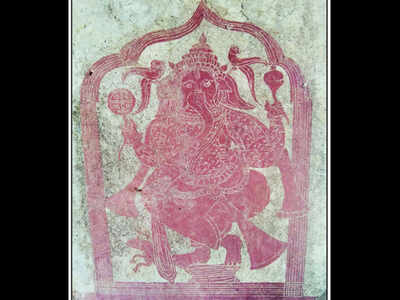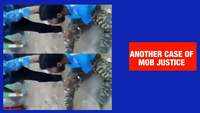
KERI: Since times immemorial, Lord Ganesha has been an inspiration for artisans across the country. With the elephant-headed god prominently featuring in Kaavi art and wood carving, Goa was no exception.
Kaavi is a form of painting on the inner and outer walls of sacred places in beautiful reddish-brown murals. Lime plaster is predominantly used to create such art works. Designs are etched with ‘kaav’, a paste made from fine red soil, charcoal and a blend of crushed leaves, flowers and the sap of vines.
Most of the temples in pre-Portuguese era were rich in Kaavi art.
Among the deities in the Hindu pantheon, Ganesha is widely worshipped, which is why many temples have at least one image of the elephant-headed god in such art works.
In Caranzol area of Sattari, the temple of Shantadurga is painted with murals using chemical colours. It was previously known for rich specimens of Kaavi art. The four-handed Kaavi mural of Ganesha in seated posture used to be a huge draw.
On the ‘prabhaval’ (a circular halo that is shown close to the face of the deity), painting of two parakeets on the either sides were reflecting love of people for avi-fauna.
Lord Ganesha also hugely influenced the carpenter community here. Many Goan temples displayed beautifully wooden-carved panels depicting the state’s religious, cultural and biological heritage.
Among the carpenter communities, the ‘Chitari’ families were experts in wood carving and painting too. While their wooden designs had images of various gods and goddesses, Ganesha would feature in at least three or four carvings.
“Goa used to be known once for its skilled wood carving. The carpenter communities in most villages had inherited this form of art. However, only a few temples showcase it today. There is a need to protect and conserve this tangible cultural heritage of our land,” Sanskruti Naik, a fine art instructor, said.
Ganesha in carved wooden panels and Kaavi art forms once flourished in Goa. However, lack of patronage from the government and locals forced these traditional art forms into oblivion.
Kaavi is a form of painting on the inner and outer walls of sacred places in beautiful reddish-brown murals. Lime plaster is predominantly used to create such art works. Designs are etched with ‘kaav’, a paste made from fine red soil, charcoal and a blend of crushed leaves, flowers and the sap of vines.
Most of the temples in pre-Portuguese era were rich in Kaavi art.
Among the deities in the Hindu pantheon, Ganesha is widely worshipped, which is why many temples have at least one image of the elephant-headed god in such art works.
In Caranzol area of Sattari, the temple of Shantadurga is painted with murals using chemical colours. It was previously known for rich specimens of Kaavi art. The four-handed Kaavi mural of Ganesha in seated posture used to be a huge draw.
On the ‘prabhaval’ (a circular halo that is shown close to the face of the deity), painting of two parakeets on the either sides were reflecting love of people for avi-fauna.
Lord Ganesha also hugely influenced the carpenter community here. Many Goan temples displayed beautifully wooden-carved panels depicting the state’s religious, cultural and biological heritage.
Among the carpenter communities, the ‘Chitari’ families were experts in wood carving and painting too. While their wooden designs had images of various gods and goddesses, Ganesha would feature in at least three or four carvings.
“Goa used to be known once for its skilled wood carving. The carpenter communities in most villages had inherited this form of art. However, only a few temples showcase it today. There is a need to protect and conserve this tangible cultural heritage of our land,” Sanskruti Naik, a fine art instructor, said.
Ganesha in carved wooden panels and Kaavi art forms once flourished in Goa. However, lack of patronage from the government and locals forced these traditional art forms into oblivion.
Trending Topics
LATEST VIDEOS
More from TOI
Navbharat Times
Featured Today in Travel
Quick Links
Lok Sabha Election Schedule 2019Lok Sabha Election NewsDelhi Capitals teamMI team 2019Rajasthan Royals 2019RCB team 2019Maharashtra Lok Sabha ConstituenciesBJP Candidate ListBJP List 2019 TamilnaduShiv Sena List 2019AP BJP List 2019Mamata BanerjeeBJP List 2019 MaharashtraPriyanka GandhiBJP List 2019 KarnatakaAMMK Candidate List 2019BJP List 2019 WBLok Sabha Elections in Tamil NaduBSP List 2019 UPNews in TamilLok Sabha Poll 2019Satta Matka 2018PM ModiMahagathbandhanNagpur BJP Candidate ListChandrababu NaiduTamil Nadu ElectionsUrmila MatondkarNews in TeluguMadras High CourtTejashwi YadavArvind KejriwalTejasvi SuryaPawan KalyanArvind KejriwalYogi AdityanathJaya PradaSatta King 2019Srinagar encounter
Get the app







